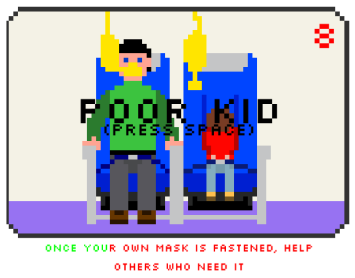By Joel Smart (The Cascade) – Email
Date Posted: October 25, 2011
Print Edition: October 19, 2011
 After years of debate as to whether games can be art, one designer, Dr. Pippen Barr, asked himself if art could be a game. He set off to recreate the piece Marina Abramovic performed at The Museum of Modern Art (MoMA) in 2010, and he’s getting a lot of the same responses she did. Abramovic sat down at a wooden table, and did not move for 736 hours and 30 minutes. Museum attendees stood in line, waiting for a chance to sit with her. The experience of standing in line only to be underwhelmed by the end result is now a playable experience, thanks to Barr. The Artist is Present challenges the idea of what constitutes a game in just the way the original piece challenged the boundaries of art. Its artfulness is in the dialogue it opens up about art itself.
After years of debate as to whether games can be art, one designer, Dr. Pippen Barr, asked himself if art could be a game. He set off to recreate the piece Marina Abramovic performed at The Museum of Modern Art (MoMA) in 2010, and he’s getting a lot of the same responses she did. Abramovic sat down at a wooden table, and did not move for 736 hours and 30 minutes. Museum attendees stood in line, waiting for a chance to sit with her. The experience of standing in line only to be underwhelmed by the end result is now a playable experience, thanks to Barr. The Artist is Present challenges the idea of what constitutes a game in just the way the original piece challenged the boundaries of art. Its artfulness is in the dialogue it opens up about art itself.
Barr, who lives in Denmark and teaches a course in experimental interaction at the IT University of Copenhagen, explains on his blog inininoutoutout that the game came from the way he found himself “constantly asking why about each element of a design or game.” For a game that seeks other goals other than being fun, this is an increasingly important question to ask – and as Barr notes, it can also be quite difficult to answer. Working from this perspective, Barr explained his game as having two particular intentions – one to illustrate how “antithetical” waiting is to gaming (consider how much people complain about loading screens), and secondly, to criticise the approach contemporary games take in ensuring “fairness.” Real life isn’t fair, he told Gamasutra. “Commercial games have really coalesced into a very specific set of things that are considered acceptable. They center around the idea that the player shouldn’t be inconvenienced – that they should be treated fairly,” he said. “They have a fallacy that the world is fair. We all know the world is not a fair place. Good things don’t always happen to good people.” His goal, he explained, was to make a game on the other side of the spectrum, because that pressure towards fairness was restrictive.
It isn’t the first game he’s made that has attempted to tackle questions of morality, or challenge traditional patterns or thoughts. For example, another game he made this year, Let There Be Smite!, faced players with a barrage of ethical conundrums to which they were forced to decide for the individuals in question – forgive or smite? In GuruQuest, a text adventure, players are challenged to beat the guru at his own game, as they consult with him on any matter of their hearts’ desires. In Trolley Problem, players have just one chance to test themselves in “a series of gruelling ethical challenges from the all-time classic ethical thought experiments from philosophy.” Perhaps it is no coincidence that Barr did his Ph.D. dissertation on “video game values.”
He even took a stab at a common “serious games” idea: “could the booklet showing safety instructions on an airplane work better as a game?” In his game, Safety Instructions, players type out the instructions in a timed type-off, Mavis Beacon style. Make a mistake or fail to type the full statement before the 10-seconds runs out and you’ll have to watch the horrific consequences before you can retry the scene. Sometimes—such as in the case of helping a child put on his oxygen mask—failing doesn’t result in a retry, instead you simply move on to the next scene *despite* the horrific consequences. The game is more light-hearted than it sounds.
Barr explained on his blog, however, that he prefers the description “curious game” instead of “serious game” because the connotations are better. “Games seen in this light might be thought of as asking some kind of question or poking around a subject, rather than ‘solving a problem’ as some recent discussion described game design as. Game making as problem solving is kind of depressing to me personally – game making as question-asking sounds fun!” It’s a valid criticism of the serious game train-of-thought, and one that says a lot about his current design philosophy.
With The Artist is Present, Barr has challenged notions of gaming, while doing a fairly decent job of emulating something that MoMA declared art. In fact, the free-to-play game on his website “closes” at the same time as the museum, meaning you can only really play the game between 10:30 a.m. and 5:30 p.m. (EDT). The line up is long enough that he actually hopes most people will get bored and quit after a couple minutes. When Rosie Gray told Barr in an interview with the Village Voice that she gave up because the line was so long, he responded with exuberance. “That’s so authentic!”

